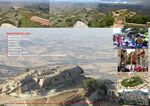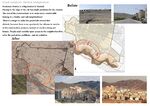LED Online Seminar 2017 - Working Group 10
--> Back to working group overview
Dear working group members. This is your group page and you will be completing the template gradually as we move through the seminar. Good luck and enjoy your collaboration!
Assignment 1 - Reading and Synthesizing Core Terminology
- You can read more details about this assignment here
- Readings are accessible via the resources page
Step 1: Your Landscape Democracy Manifestoes
Step 2: Define your readings
- Please add your readings selection for the terminology exercise before April 12:
A: Landscape and Democracy - Mapping the Terrain
- Landscape Democracy Resolution (Angelo.l)
Landscape Concepts:
- Burckhardt, Lucius (1979): Why is landscape beautiful? in: Fezer/Schmitz (Eds.) Rethinking Man-made Environments (2012) (Fouad)
- Accompanying lecture reading: Bruns/Bartolomei, 2016 'Concepts of Landscape' (Fouad)
B: Concepts of Participation
- Day, Christopher (2002): Consensus Design, Architectural Press (Maliheh)
C: Community and Identity
- Yinglan Reading - Hester, Randolph (2006): Design for Ecological Democracy, The MIT Press
D: Designing
- Pritzker Prize winning architect Alejandro Aravena on sustainable design and community involvement in Chile (Angelo.l)
E: Communicating a Vision
- Niels De Couvreur => 'Reading the Landscape' by Simon Bell, EMU Tartu
Steps 3 and 4: Concepts Selection and definition
- Each group member selects three relevant concepts derived from his/her readings and synthesize them/publish them on the wiki by April 30, 2017
- Group members reflect within their groups and define their chosen concepts into a shared definition to be posted on the wiki by May 10, 2017.
- Other group members will be able to comment on the definitions until May 20, 2017
Concepts and definitions
Angelo.l :
- Landscape democracy
- Landscape democracy is represented by all citizens are meant to partecipate equally
- Participatory design
- Include the community in the design, in the way of find the solution through the participatory design process for identify with precision the problems
- The force of life into heart of architecture
- Any type of construction, the use of common sense and the power of nature, through the design power synthesis, must be translated into form through the force of life
Mulla:
- Landscape Concepts
- The rule of Ruins in landscape patterns and atmosphere
- Landscape Design Concepts
- Value that people can give to areas in their surroundings- Valiable placies
Niels De Couvreur:
=> Communicating a Vision
- Dissecting the landscape to individual layers and combining these; makes it possible to define the landscape characteristics.
- The landscape is a very complex matter to understand and making a basic classification makes it understandable.
- The human influence on the landscape is the last in the hierarchy of the landscape.
- We as human beings are the last part of a much bigger story, however we see our position at the top. We need to find our correct place when we are at a decision-making position toward the landscape.
- Landscape sketches as a basic tool
- The landscape is one of the most complex matters and has connections to various parts of the society. To make this complex matter understandable for all parts of society is crucial to make it accessible for everybody.
Yinglan Liang:
- Ecological Democracy -
the destruction of ecology is the process of recycling,such as now human beings are destroying the environment and the problems of the environment will affect the lives of the next generation .
- Design of city and landscape together -
changes in the living environment must follow three basic feature .
- .......
Step 5: Reflection
- Please write, as a group, a 250 words reflection on your discourse and document it here
Step 6: Revised manifestoes
- please look again at your initial manifestoes and update them with any new aspects/prespectives you have taken up during this seminar
- Updatedmanifesto1.jpg
xy's updated manifesto
- Updatedmanifesto2.jpg
xy's updated manifesto
- Updatedmanifesto3.jpg
xy's updated manifesto
- Updatedmanifesto4.jpg
xy's updated manifesto
- Updatedmanifesto5.jpg
xy's updated manifesto
Assignment 2 - Your Landscape Symbols
- You can read more details about this assignment here
Landscape Symbols Author 1
Landscape Symbols of Fouad Mulla
- Symbol yourname photovoice3
add a caption (one paragraph max) description of the symbolism, interpretation, as well as geo-location
- Symbol yourname photovoice4
add a caption (one paragraph max) description of the symbolism, interpretation, as well as geo-location
- Symbol yourname photovoice5
add a caption (one paragraph max) description of the symbolism, interpretation, as well as geo-location
Landscape Symbols of Yinglan
The fortress - was built between 1622 and 1638. Inside the fortress stands Guia Chapel, originally established by Clarist nuns, who resided at the site before establishing the Convent of St. Clare. The chapel's elaborate frescoes depict representations of both western and Chinese themes, displaying motifs of religious and mythological inspiration that are a perfect example of Macao's multicultural dimension.
- Symbol yourname photovoice4
add a caption (one paragraph max) description of the symbolism, interpretation, as well as geo-location
- Symbol yourname photovoice5
add a caption (one paragraph max) description of the symbolism, interpretation, as well as geo-location
Landscape Symbols Niels De Couvreur
- Symbol yourname photovoice4
add a caption (one paragraph max) description of the symbolism, interpretation, as well as geo-location
- Symbol yourname photovoice5
add a caption (one paragraph max) description of the symbolism, interpretation, as well as geo-location
Landscape Symbols Maliheh Shhaghadami
Burgplatz in Dusseldorf is located on the site of the old castle in Dusseldorf which was built in 13th century at Rheine river. The castle had attracted so many attentions as a painting gallery an later became parliament of Rheinland in Germany. After several fires only the castle tower was preserved. At the Burgplatz the northern Düssel flows into the Rhine, where the banks can be reached by a free-standing staircase. Especially this staircase is a popular meeting place for locals and tourists in summer as public space.
Konigsallee is an urban boulevard in city center of Düsseldorf,Germany. By the end of the 18th century,the duke decided to give room for a more generous urban plan, This plan was made by architects and landscape architects. Later on 2014 the boulevard have been developed as the office and retail center.
- Symbol yourname photovoice3
add a caption (one paragraph max) description of the symbolism, interpretation, as well as geo-location
- Symbol yourname photovoice4
add a caption (one paragraph max) description of the symbolism, interpretation, as well as geo-location
- Symbol yourname photovoice5
add a caption (one paragraph max) description of the symbolism, interpretation, as well as geo-location
Landscape Democracy Challenge -Yinglan
- Redtory-canning factory transformation
- Yourname challenge 3.jpg
caption: what is the issue/conflict (2)
Your references:
Landscape Democracy Challenge 5
- Give a title to your challenge
- Yourname challenge 4.jpg
My challenge is the reorganization of the road and the repair of collapsed roads or in bad conditions. The actors of this renewal are young architects in collaboration with representatives specializing in different sectors. An active design for the creation of paths, to decrease the density of some areas favoring public spaces.
- '''Your references:'''
- *...
- *...
- == Assignment 5 - Your Democratic Change Process ==
- *After documenting and reflecting on your challenges you will continue jointly with one of these challenges and design a democratic change process
- === Your Democratic Change Process ===
- Yourgroupname 2017 powermap.jpg
a power map identifying who is affected by the challenge and who is influencing it
- Yourgroupname 2017 change process (1).jpg
Look at the various methods and tools available and think how they can be applied creatively. Think about the needs of different stakeholder groups - you may need a methodical mix to address them all. Illustrate graphically how these methods/tools might be applied in a short, medium and long-term perspective.
- Yourgroupname 2017 scenario.jpg
a scenario illustrating how these tools can be applied within a short, medium and long term perspective involving the groups you want to address, this should include a process timeline
Reflection
- Evaluate in the group how far your ideas either built on the theoretical frame that has been introduced to you during this seminar or react to this by filling a potential gap (approx 150 words)
Your references
- ....
- ....
- ....
- ....






















